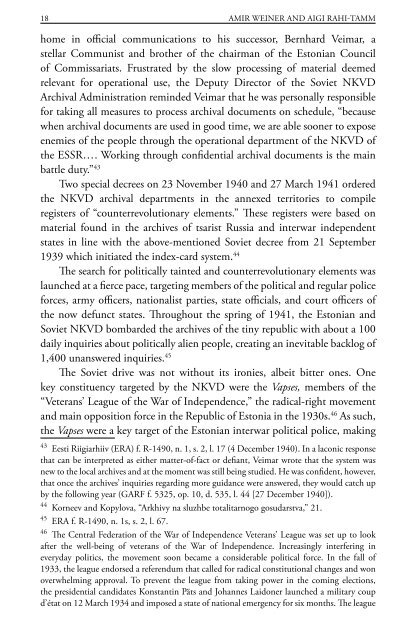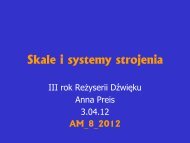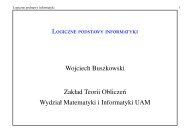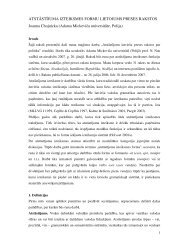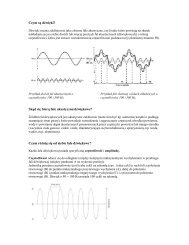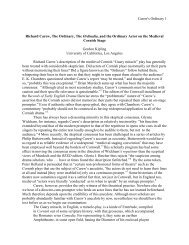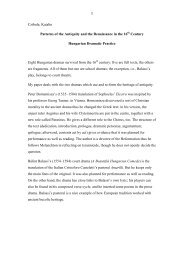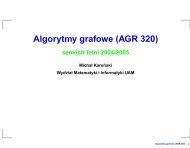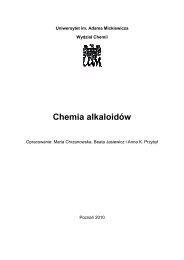Amir Weiner Getting to Know You
Amir Weiner Getting to Know You
Amir Weiner Getting to Know You
Create successful ePaper yourself
Turn your PDF publications into a flip-book with our unique Google optimized e-Paper software.
18 AMIR WEINER AND AIGI RAHI-TAMM<br />
home in official communications <strong>to</strong> his successor, Bernhard Veimar, a<br />
stellar Communist and brother of the chairman of the Es<strong>to</strong>nian Council<br />
of Commissariats. Frustrated by the slow processing of material deemed<br />
relevant for operational use, the Deputy Direc<strong>to</strong>r of the Soviet NKVD<br />
Archival Administration reminded Veimar that he was personally responsible<br />
for taking all measures <strong>to</strong> process archival documents on schedule, “because<br />
when archival documents are used in good time, we are able sooner <strong>to</strong> expose<br />
enemies of the people through the operational department of the NKVD of<br />
the ESSR… . Working through confidential archival documents is the main<br />
battle duty.” 43<br />
Two special decrees on 23 November 1940 and 27 March 1941 ordered<br />
the NKVD archival departments in the annexed terri<strong>to</strong>ries <strong>to</strong> compile<br />
registers of “counterrevolutionary elements.” These registers were based on<br />
material found in the archives of tsarist Russia and interwar independent<br />
states in line with the above-mentioned Soviet decree from 21 September<br />
1939 which initiated the index-card system. 44<br />
The search for politically tainted and counterrevolutionary elements was<br />
launched at a fierce pace, targeting members of the political and regular police<br />
forces, army officers, nationalist parties, state officials, and court officers of<br />
the now defunct states. Throughout the spring of 1941, the Es<strong>to</strong>nian and<br />
Soviet NKVD bombarded the archives of the tiny republic with about a 100<br />
daily inquiries about politically alien people, creating an inevitable backlog of<br />
1,400 unanswered inquiries. 45<br />
The Soviet drive was not without its ironies, albeit bitter ones. One<br />
key constituency targeted by the NKVD were the Vapses, members of the<br />
“Veterans’ League of the War of Independence,” the radical-right movement<br />
and main opposition force in the Republic of Es<strong>to</strong>nia in the 1930s. 46 As such,<br />
the Vapses were a key target of the Es<strong>to</strong>nian interwar political police, making<br />
43 Eesti Riigiarhiiv (ERA) f. R-1490, n. 1, s. 2, l. 17 (4 December 1940). In a laconic response<br />
that can be interpreted as either matter-of-fact or defiant, Veimar wrote that the system was<br />
new <strong>to</strong> the local archives and at the moment was still being studied. He was confident, however,<br />
that once the archives’ inquiries regarding more guidance were answered, they would catch up<br />
by the following year (GARF f. 5325, op. 10, d. 535, l. 44 [27 December 1940]).<br />
44 Korneev and Kopylova, “Arkhivy na sluzhbe <strong>to</strong>talitarnogo gosudarstva,” 21.<br />
45 ERA f. R-1490, n. 1s, s. 2, l. 67.<br />
46 The Central Federation of the War of Independence Veterans’ League was set up <strong>to</strong> look<br />
after the well-being of veterans of the War of Independence. Increasingly interfering in<br />
everyday politics, the movement soon became a considerable political force. In the fall of<br />
1933, the league endorsed a referendum that called for radical constitutional changes and won<br />
overwhelming approval. To prevent the league from taking power in the coming elections,<br />
the presidential candidates Konstantin Päts and Johannes Laidoner launched a military coup<br />
d’état on 12 March 1934 and imposed a state of national emergency for six months. The league


